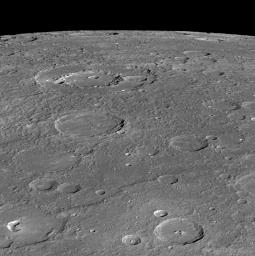
|
On the Horizon
- Click the image above for a larger view
- Full-Res JPEG (1020 x 1024) (165.8 kB)
- Full-Res TIFF (1020 x 1024) (1.0 MB)
Caption:
Three named craters are featured prominently in this view. The peak-ring basin Wang Meng is toward the horizon, while the pit-floor crater Glinka is near the bottom left. Judah Ha Levi is about half way in between the two.
This image was acquired as part of MDIS's high-incidence-angle base map. The high-incidence-angle base map complements the surface morphology base map of MESSENGER's primary mission that was acquired under generally more moderate incidence angles. High incidence angles, achieved when the Sun is near the horizon, result in long shadows that accentuate the small-scale topography of geologic features. The high-incidence-angle base map was acquired with an average resolution of 200 meters/pixel.
Date acquired:
November 16, 2013
Image Mission Elapsed Time (MET):
26888421
Image ID:
5205547
Instrument:
Wide Angle Camera (WAC) of the Mercury Dual Imaging System (MDIS)
WAC filter:
7 (748 nanometers)
Center Latitude:
10.04°
Center Longitude:
251.2° E
Resolution:
292 meters/pixel
Scale:
Wang Meng has a diameter of 165 km (103 miles)
Background Info:
The MESSENGER spacecraft is the first ever to orbit the planet Mercury, and the spacecraft's seven scientific instruments and radio science investigation are unraveling the history and evolution of the Solar System's innermost planet. MESSENGER acquired over 150,000 images and extensive other data sets. MESSENGER is capable of continuing orbital operations until early 2015.
For information regarding the use of images, see the MESSENGER image use policy .
Cataloging Keywords:
| Name | Value | Additional Values |
|---|---|---|
| Target | Mercury | |
| System | ||
| Target Type | Planet | |
| Mission | MESSENGER | |
| Instrument Host | MESSENGER | |
| Host Type | Orbiter | |
| Instrument | Mercury Dual Imaging System (MDIS) | |
| Detector | Wide Angle Camera (WAC) | |
| Extra Keywords | Crater, Grayscale, Map, Radio, Shadow | |
| Acquisition Date | ||
| Release Date | 2013-12-16 | |
| Date in Caption | 2013-11-16 | |
| Image Credit | NASA/Johns Hopkins University Applied Physics Laboratory/Carnegie Institution of Washington | |
| Source | photojournal.jpl.nasa.gov/catalog/PIA17787 | |
| Identifier | PIA17787 | |
